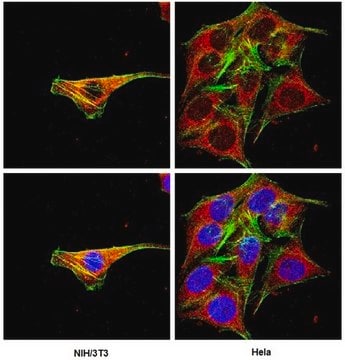SCR508
TAT-CRE Recombinase
TAT-CRE Recombinase is a recombinant cell-permeant fusion cre-recombinase protein consisting of TAT sequence, a nuclear localization sequence (NLS) and it is known to catalyze the site specific recombination event between two loxP DNA sites.
Synonim(y):
Integrase, Recombinase Cre, cre recombinase
Wybierz wielkość
2770,00 zł
Przewidywany termin wysyłki01 kwietnia 2025Szczegóły
Wybierz wielkość
About This Item
2770,00 zł
Przewidywany termin wysyłki01 kwietnia 2025Szczegóły
Polecane produkty
pochodzenie biologiczne
Escherichia coli
Poziom jakości
rekombinowane
expressed in E. coli
Próba
>70% (SDS-PAGE)
Formularz
liquid
metody
cell culture | stem cell: suitable
Warunki transportu
dry ice
Opis ogólny
• If LoxP sites are located on different chromosomes, Cre recombinase will mediate a chromosomal translocation.
• If LoxP sites are oriented in the opposite direction, Cre recombinase will mediate an inversion of the floxed segment.
• If LoxP sites are oriented in the same direction, Cre recombinase will mediate a deletion of the floxed segment.
In this way, placement of the LoxP sites allows genes to be activated, repressed or exchanged for other genes.
EMD Millipore’s TAT-CRE Recombinase is a recombinant cell-permeant fusion protein consisting of a basic protein translocation peptide derived from HIV-TAT (TAT), a nuclear localization sequence (NLS), the Cre protein and an N-terminal histidine tag (H6) for efficient purification of the protein from E. coli.
EMD Millipore’s TAT-CRE Recombinase has been shown to effectively excise STEMCCA viral transgenes from both Human and Mouse IPS cells.
Zastosowanie
Jakość
- Purity: single band around 41 kDa with greater than 70% protein purity on an SDS-PAGE gel
- Functional activity: mediates recombination of LoxP-modified alleles in a HEK293T- Cre reporter cell line
- Endotoxin levels: less than 1 EU/ug protein
Definicja jednostki
Postać fizyczna
Przechowywanie i stabilność
Kod klasy składowania
10 - Combustible liquids
Klasa zagrożenia wodnego (WGK)
WGK 1
Certyfikaty analizy (CoA)
Poszukaj Certyfikaty analizy (CoA), wpisując numer partii/serii produktów. Numery serii i partii można znaleźć na etykiecie produktu po słowach „seria” lub „partia”.
Masz już ten produkt?
Dokumenty związane z niedawno zakupionymi produktami zostały zamieszczone w Bibliotece dokumentów.
Produkty
Fibroblast growth factors (FGFs) regulate developmental pathways and mesoderm/ectoderm patterning in early embryonic development.
Czynniki wzrostu fibroblastów (FGF) regulują szlaki rozwojowe i kształtowanie mezodermy/ektodermy we wczesnym rozwoju embrionalnym.
Protokoły
Stem cell reprogramming protocols to generate human induced pluripotent stem cells (iPSCs) including viral and non-viral RNA based methods.
Active Filters
Nasz zespół naukowców ma doświadczenie we wszystkich obszarach badań, w tym w naukach przyrodniczych, materiałoznawstwie, syntezie chemicznej, chromatografii, analityce i wielu innych dziedzinach.
Skontaktuj się z zespołem ds. pomocy technicznej






